Review: Better Ride private lesson
Tuesday I had a private lesson with Gene Hamilton
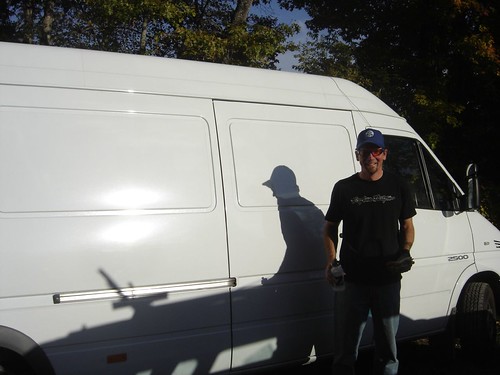
of Better Ride.net

I'm writing this entry to help put into words what I learned to help it sink in. Please don't take what I write as gospel. As I've said a hundred times. I'm just a hack, and I didn't even stay in a Holiday Inn last night. And it's not like I'm giving away any Bette Ride trade secrets. The reason you hire someone like Gene is because he can TEACH an individual the right stuff, not because he's got some super top-secret I could tell ya but I'd have to kill ya techniques.
Gene is an expert certified mountain bike coach, a professional downhiller,
 a silver and a bronze medal winner at the world downhill championships... He has been putting on skills camps for several years and several people at MTBR forums have spoken extremely highly of him. So he's not one of those pros that can just do but not teach. He's definitely a hard guy to get a hold of on email due to his travel schedule. But we finally worked a day out.
a silver and a bronze medal winner at the world downhill championships... He has been putting on skills camps for several years and several people at MTBR forums have spoken extremely highly of him. So he's not one of those pros that can just do but not teach. He's definitely a hard guy to get a hold of on email due to his travel schedule. But we finally worked a day out.Why would someone like myself spend a significant amount of cash on skills training you might ask. I've been riding for 15+ years. And anyone, especially on the east coast with that much saddle time has got to have some skills. In a nutshell--> I just wanted to get better. I sort of know what needs to be done to get better, but often times, as analytical a person I am then end result is second guessing and even more lack of confidence in the skill in question. At this point in my mountain biking life, I don't want to do trial and error learning. A lot of people say that you just need time in the saddle. Or that practice makes perfect. But if you aren't doing it right to begin with that isn't going to help. The phrase Gene uses is Perfect practice makes perfect.
And I know that one lesson is not going to make me a freerider or a gap jumper
 . Realistically what I am looking for is that improvement in skills/efficiency that can get me 1/2second here to 1 second there on each trail feature (turns, rocks, etc.) Over the course of a race these can add up to several minutes which can be the difference between several placings. But the bottom line really: Faster= more funner. Whether it is up or down.
. Realistically what I am looking for is that improvement in skills/efficiency that can get me 1/2second here to 1 second there on each trail feature (turns, rocks, etc.) Over the course of a race these can add up to several minutes which can be the difference between several placings. But the bottom line really: Faster= more funner. Whether it is up or down.And just like the coaching I got this year from Dave Morris had a HUGE impact on me, I sought out some skills coaching. So that I could get the straight up gospel from a PRO-fessional.....do it like this.... Sure there are several ways to skin a cat, but here I get one method that works and can learn it, drill it in, and make it part of my riding.
I originally was going to do one of his Camps in Richmond earlier in August. But the camp sold out. He had another camp next week and I opted for a private lesson locally rather than the 3 day camp. My reasoning was that I had decent skills and might get more out of a customized lesson, and I'd save on the 2 days lodging and save 2 days of overnight travel. And anyone with spouse and kids knows how stressful overnight travel is on your significant other.
But in hindsight I wish that I'd done the camp over the private lesson. There was just SOSOOSOSO much information that it was getting to the point of overload, and even I, a person that can not converse about anything outside of cycling and can talk forever about bikes was reaching the point of nodding my head and glazed eyes.

With the multiday camp, the information would have been split out over 3 days and each day would allow opportunity to assimilate it, and offer some trail time to reinforce the skills.
The crux of Gene's philosophy on skills is drilling the fundamentals. Any professional player or coach in almost all sports will say that all advanced skills are grounded in the fundamentals. Pro basketball players do
 after free throw. Martial arts experts continually practice their basic movements
after free throw. Martial arts experts continually practice their basic movements  . Soccer is grounded in the fundamental touches of the ball:
. Soccer is grounded in the fundamental touches of the ball: 
Mountain biking is no different. Gene was able to work with me on some of the fundamentals but there were more that we didn't have time to touch on. Ironically, Gene mentioned several occasions where he wasn't following the fundamentals, such as riding right into a rock because he was staring at it, or having to remind himself ever minute to look up. It just drives home the fact that even a pro, and a teacher has to constantly work on the fundamentals.
Prior to the lesson, I wasn't sure what to except. I knew there would be some drills and stuff but I was thinking we would ride to each of the 'thorn in my side' spots on my local trail like some switchbacks or rock drop offs that give me trouble and thought we'd work on each one.
Well, in 4 hours of instruction we spent 99.5% on a paved road. What a gyp you might be thinking? I was at first as well, but after a little while I soon realized as he explained to me that there is NO way that you can work on these skills on the a dirt trail. You can't concentrate on the skill when you are worried about sliding, out face planting, running into a tree, etc.etc.. It is sort of like doing an interval work out on a trainer vs a busy road. You just can't put your head down and hammer when you are thinking about cars, potholes or running off the road.
I think given the short amount of time and the large amount of things I wanted to learn this was the best way. I know in his other camps and clinics they is more trail time. But I'd filled out his athlete questionaire with all the goals I had for the camp, and it was quite unrealistic that we'd cover all of them, especially if there was lost time riding from one technical spot to another.
I came close to face planting on the road too, so couldn't imagine it on dirt. Interestingly enough, I hardly 'rode' more than 1/2mile I'd expect during the whole lesson. But later that day I was utterly worked. That kind of weary, irritable tiredness you feel after an epic ride, except my legs weren't worked. But my mind was just fried after focusing so much
The areas we worked on included:
Mental Game
Body position
Vision
Cornering
Braking
Coaster and pedal wheelies
These fundamentals also were the basis for bunny hops and switchbacks.
And it's not like these are skills that are hidden away in some treasure chest that only the select few know about. I've read about all this stuff for years in books like: Single track mind:

Ned's book:

Lee's book:

Keith Code's archaic book:

(BTW Code's book has some neat information, but it is written terribly, and more often than not this book screwed me up more than it helped)
And every freaking skills article in MBA, Mountain Bike, Bicycling, velonews and on and on. But you never know if it is good info or a crock. Some stuff is so old it isn't viable any more, other stuff is just plain wrong. But what do I know. If it is written in Mountain Bike Action than it has got to be true, right?
And just like the fitness related coaching I got wasn't rocket science or magic. But someone like this telling me what I already know makes it sink in. And having someone show me, and help me figure out what it FEELS like is priceless, and NO book, and NO video is going to do that for you.
We also talked about bike setup. It was nice for him to validate a lot of my setup that I've spent countless hours tinkering with. Like Brake lever setup, etc. We talked about fork sag which was something I needed to learn more about. I set fork sag on level ground, but his philosophy is that on a downhill, more weight goes on the front and sag was set on flat ground than it is going to be too soft when going downhill. So rolled while standing up and then rocked forward and we checked how much that caused the fork to move. Too much. More air pressure needed in main spring. Stem length was another thing where I was on track. Gene is a huge proponent of the short stem. Under 80mm if possible.
Gene had a cool gadget that he raved on. It was a thumb lever actuated seatpost that allowed him to lower the saddle 3" on the fly.

Just like the Hite-rites of old. I totally remember stopping and lowering my seatpost with a quickrelease to ride some gnarly section. But being the weight weenie/XC geek I am there is now way I'd have a quick release or stop to change saddle height on the trail. But this
Gravity Dropper seatpost looked like something viable even for an XC weight weenie. So many times during the lesson I realized how much and XC level height saddle gets in the way.
Here's my take on some of the concepts
Mental
We all know that most of this stuff is on our heads. I'm older now, wiser I don't want to get hurt. My biggest obstacle isn't the trail it is my brain. Gene quoted one of the great masters of all time Jedi Yoda:

"Do or Do not. There is no try"
The word try, has an implication of failure, and Do does not. Of course this is a tough one to get over, but I'll try. hah ha. No I will do.
Smiling was another key point. Smiling releases endorphins that relax us. And what s the worst thing you can be when you hit a rock garden? Tense.
Finally he mentioned the rule of 3s. I've heard this before. When practicing something specific stop after 3 times and do something else. After 3 times you get diminishing returns.
Body position
There is a sweet spot on the bike, where almost all your weight rests on the pedals. Lee McCormacks' book talks about this but he didn't give it as much attention as it deserves. The weight on your bars only amounts to the weight of your forearm. That's the place to be. When you're there the bikes just floats under you. Upper body low dipped towards the bar, elbows up and out wide. The elbows part is really hard for me. That is going to take some work.
It's the image that comes to mind when I think downhiller.
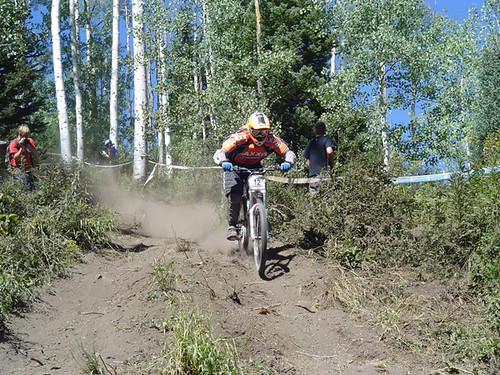
But there is no reason why it shouldn't be the similar for XC.
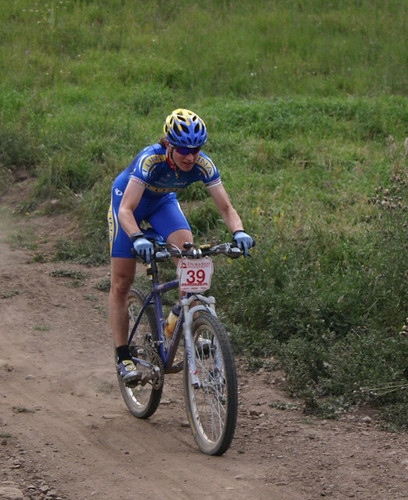
Elbows out on climbs also allows you to breathe better.
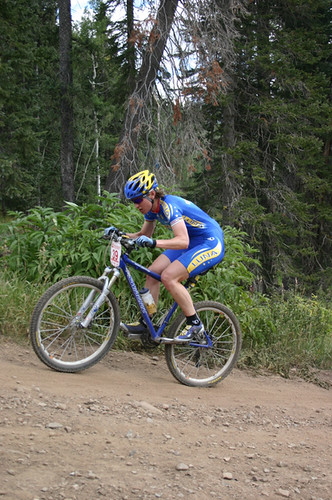
I know I've been keeping my elbows tucked in too much and never realized how much it can constrict breathing.
Finding that sweet spot took a little while riding back and forth. W/o the usual weight on the bars and with a super light grip I noticed the bike wobbling back and forth. But as soon as I got aggro and got my chest down and elbows wide was just SOLID. The only problem was I could really feel it in my lower back with my chest down low and flat back. I hope this improves with time.
Also everything on a mountain bike is dynamic. Always moving up down sideways, etc. As the terrain changes we adapt to it. The key is keeping your center of gravity (COG) over the Bottom bracket.
Critically tied to body position is head position: UP and LEVEL. This again is nothing new and revolutionary. Blair Lombardi had talked about this years ago. The level head relates to the fluid levels in our inner ear:
 When the head tilts changes the fluid level which in turn affects our balance.
When the head tilts changes the fluid level which in turn affects our balance. This leads to another fundamental: Vision where to look and how to look.
It was funny, Gene said if you take anything away from this lesson it is about vision. I was sort of saying to myself, yeah yeah I know this, when do we get to learn about gap jumps...But Oh MY GOD. Vision was the baddest skill he showed me. It was absolutely core to every single thing we did. And when I had my vision right I nailed every drill, but when the vision went south, I'd crash and burn on the drills. It was so amazing how much affect positive or negative it has.
Again, you've heard all this stuff for years. Don't look down, look where you want to go, scan up and down. Keith Code talked about Reference Points in his book but it was explained so poorly I never figured it out till now. The keys for me were:
-See and object or feature (rock, root, berm, etc.)
-Register it in the mind. I call it marking it.
-Then look beyond it to the next feature or further up.
Gene has these two drills called Voodoo mind tricks. Where he places obstacles in the road and you have to ride to them and pull your wheel up or ride between them but you have to look at something in the far off distance, head up/level.
I had the BIGGEST SMILE on my face when I did these drills. It was SO amazing the power of your mind and peripheral vision. My body totally knew what to do and how to time the wheel loft properly. I didn't have to think about it. YEAH boy. I'm getting it. Now putting it into practice is going to be something different.
LOOK to VICTORY

What's that mean? ...Well if I tell ya, I'll have to kill ya..
It means: Keep yo head up Foo!
Getting the front wheel up
Coaster wheelies, and pedal wheelies. It's all about the weight shift. Not pulling up with your arms. But moving your hips back. A felt it a couple times. Most times I was the bull in the china shop with no finesse, but at least I know what the correct way feels like and have that to shoot for.
Next we worked on Cornering basics
This is one of those areas I really wanted to get the gospel on. I've read so many things about cornering and tried many things on the trail, but could never really come to a conclusion about what is the definitive method. Reading Keith Code's book really messed me wrt to cornering.
There are two ways a bicycle moves. Under 8mph you steer the bike. Just like a car. Turn the wheel to the right, and the bikes goes right. But after 8mph it's a totally different ball game. I'm not going to even try to explain it. There are many terms for it. Counter steering, counter pressure, camber thrust. There is a lot written about it in motorcycle theory. Davis Phinney talks about it in his book.
But try this. Ride along over 8mph. Give a quick short push forward to your handlebar on the left side. You will immediately turn towards the left. Even though pushing your handlebar forward on the left side equates to steering to your right.

And in turning the bike leans or dips. And if you bike goes one way you gotta go the other to keep that weight over the BB. Works the same in other sports like skiing

And of course other two wheel sports. Check this one out:
Radical countersteering, only works because he's got the engine in the back I think: Look where his wheel is pointed but which way is he turning

And on the bike:
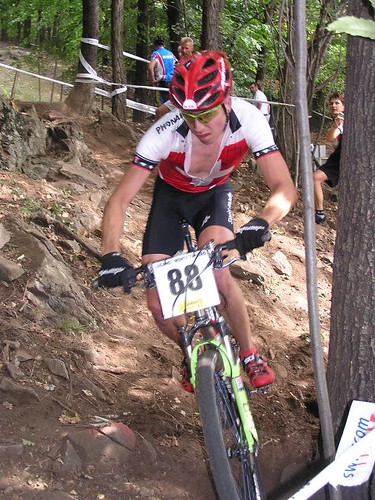
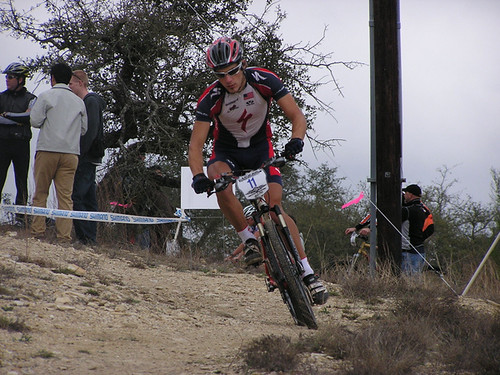
Push down on the side of the bar you want to turn. To turn tighter push more.
It's funny. When we first started this, Gene said ok ride down there and turn the the left. Push on your right side of the bar. And I did it and I wasn't going left. WTF. I pushed and pushed and was fighting to go left but couldn't. Gene had mistakenly told me to push on the wrong side. It helped drive the point home about counter steering.
There is reason they call it COUNTER steering. Cause it is SO COUNTER intuitive. Even though this is how we have been steering since we got off training wheels, actually thinking about it is counter intuitive. It took all the strength I had mentally to push harder and harder to corner tighter and lean more. And again it was so tied to vision. Rotating my head where I was going in the turn was Golden. Looking down and I'd immediately let off on the counter steer and straighten up and mess up the turn.
The best drill we did Gene calls the infinite drill. Nothing special, just riding around in a figure 8.
 With the KEY component to be looking up two cones ahead of you. So when you are at the start of the turn you are actually LOOKING at the CENTER cone. Man it was SO hard to do. But when I was able to keep my head up and rotated to the center cone as I went around the sharpest part of the turn it was AMAZING. I mean I had to have been leaned over, way way over. Like a pro man. Like you read about. I wish I had a camera or video to see how I looked, cause I bet I looked good.
With the KEY component to be looking up two cones ahead of you. So when you are at the start of the turn you are actually LOOKING at the CENTER cone. Man it was SO hard to do. But when I was able to keep my head up and rotated to the center cone as I went around the sharpest part of the turn it was AMAZING. I mean I had to have been leaned over, way way over. Like a pro man. Like you read about. I wish I had a camera or video to see how I looked, cause I bet I looked good.I definitely have a turning bias. I like to turn to the left, w/my right leg down on the outside. My right leg is my strong foot or as Hans Rey calls the "Chocolate foot"
Then he threw me a loop. He showed me how to put the hips into the turn. I had a hard time with this, and had it a couple of times. And when it clicked, man it was mind blowing.
Try this.
-Stand up put your arms forward.
-Rotate your arms to the right, but keep you belly button pointed forward and have someone push on your shoulder. It should feel fairly unstable.
-But now rotate your hips in the same direction your arms are going.
-Solid
This lead into switchbacks.

Two key things that made the biggest difference for me
-when climbing, outside pedal has to be at the power position at the apex of the turn. Ratchet the pedal as needed to get it there.
-When going down, enter as wide as possible. STEER the handlebar into the turn. LOOK to the exit as soon as possible.
Now I got them nailed, just gotta practice.
Last thing we did was bunny hops. I am not that great at them. I know the difference between just going straight up vs the porpoise or dolphin. But he explained the J hop style of bunny hop. Just like the dolphin move where your front wheel comes up and then your rear but you land flat and not on the front wheel.

I need a lot of work on this.
We talked about track stands too, but this one area where I got it down.
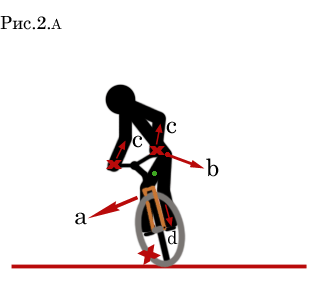 If these don't drive home the idea of weight over you BB you got problems.
If these don't drive home the idea of weight over you BB you got problems.The very first mountain bike event I ever went to in 1988 had a trials competition. I was utterly enthralled by the trials guys. And I'd go home and pratice trackstands for hours. And I can still do it, one handed and no handed for a little bit.
Braking
Again, you already know this. Most of your braking is your front brake. He set one cone up where I'd start from a dead standstill. This was on a REALLY steep paved road. Then another cone where I was supposed to brake as hard as a I could w/o endoing.
First rear brake only
then front brake only
then both.
Ok, rear brake. Man I was just skidding and skidding forever, even off the side of the road. It was a skid worthy of any 12 year old and a coaster brake.
Then the front brake only. This is where nice modulation in your brakes comes in. Juicy 7s have nice modulation. I was riding a nose wheelie a little but didn't feel in fear of endoing.
I stopped probably 25% of the distance of the rear only. I am going to take a picture of the skid soon and put it here. It was amazing comparing the difference. Again I knew this already but this really drove it home.
Then both brakes. I actually stopped farther down than just my front brake.
So how to use the brakes. ON or OFF baby. Brake hard before a turn. Not in the turn. It's all about exit speed, not entry speed. Braking actually makes your wheel stand up and in a turn you want it leaned over.
Also as you brake your body is going to move forward, you gotta move it back to counteract the force. Lee's book has some good pictures showing this.
Conclusions
Am I going to go out tomorrow and rail my favorite trail or turn pro downhiller? Probably not, in fact I might be going slower because I got so much stuff going through my head. The best thing to do will be to take one core thing and just focus on that for an entire ride. Then pick another one on the next ride. And keep doing the drills he showed me. I bet in about 3 weeks things are gonna take off.
I've been riding a long time, and in that time I've learned a lot. One thing I realized is that I'm an ok rider, pretty good actually. We all are. We often devalue our skill levels and that takes away from our confidence. And confidence is key. It was nice to have pro downhiller Gene tell me that I am doing well. At the same time I've realized how little I know seeing what Gene was able to show me in the short time he worked with me. There is so much more to learn.
In the years I've been riding there have been many of those Lightbulb over the head
 Enlightenment moments. Where you figure something out. Ahh that's how you do it. But I had more of those moments during my lesson with Gene than I have had in the last 5 years.
Enlightenment moments. Where you figure something out. Ahh that's how you do it. But I had more of those moments during my lesson with Gene than I have had in the last 5 years.I will reserve final judgement on the skills clinic until a few weeks to see if things sink in. But that also requires a dilligent commitment on my part to put into practice the things he showed me. Again I can't emphasize enough the impact on learning how these fundamentals actually feels vs reading about them or looking at pictures. I am dying to go out and practice some more and see what some of this stuff feels like on the trail. But if anything at least I've got a understanding of what the right way feels like even if I only if it was just a fleeting glimpse.
And this right here is what makes someone like Gene worth their weight in gold. And why regardless of how many years you have been riding, that you can learn something from him.
Thanks Gene for some of the best 4hrs of riding around in circles on pavement I've ever experienced. I went out to the parking lot at work two days later and repeated some of the same drills. They felt amazing. Slow but steady progression. No magic pills here.
Anyway. Definitely worth it I'd say. If you decide to go to one, let him know I sent you, cause I get points towards a special Better Ride Ginsu knife set.... But wait there's more.

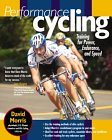
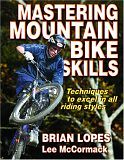
5 Comments:
GREAT story, thoroughly enjoyed. Thanks.
Wow...thanks for speding the time to write up your experience. I'll have to go back and re-read to make sure I got everything, but definitely learned a couple of things. Nice job!
I worked with Gene about 2 years ago and it was the biggest single improvement to my racing. I still have a "LOOK UP TO VICTORY" homemade sticker on the stem. I know when I see that I'm looking at the wrong place. Hope you get out and keep practicing Gene's drills, I notice improvement every time I spend a day or two working on them.
Hi
Just a comment on the photo of Mick Doohan in your counter steering paragraph.
I think the front wheel is pointing to the right because he has broken traction on the rear, and is experiencing oversteer. If he doesn't steer like this the back of the bike will attempt to become the front of the bike!! ;)
The dude is absolutely right, and there is no question.
Post a Comment
<< Home